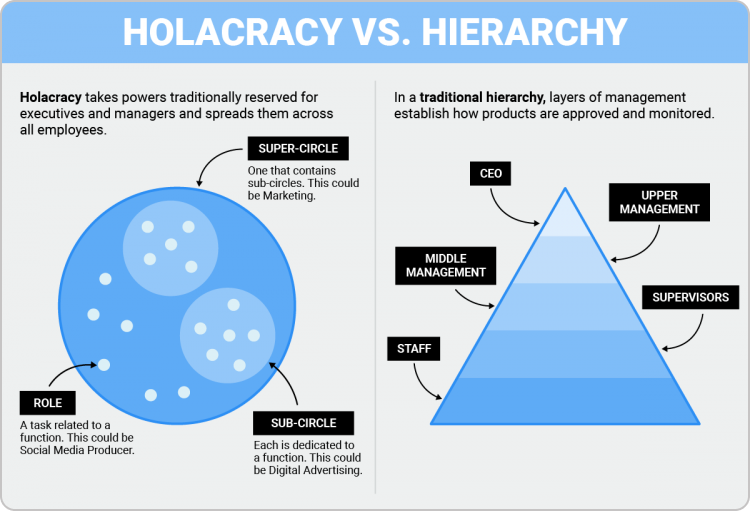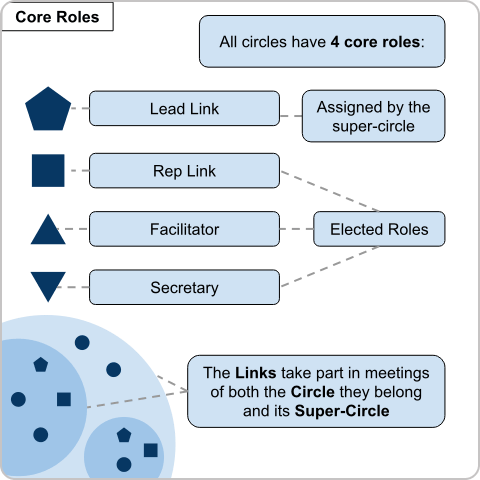One of the basic principles of the Agile approach is the ability of employees and teams to self-organize - to make independent decisions that facilitate progress, teamwork, and the development of the organization in the desired direction. Self-organization is the basis of another organizational management model - a holacracy. In this blog post, we will explain what a holacracy is, discuss its strengths and weaknesses, as well as analyze what holacracy and the Agile approach have in common.
A Sidenote
To understand the concept of holacracy, consider the human body for a moment. Its basic building block is a cell - an independent unit with a specific function. The nucleus of a cell contains genetic information, or DNA, that determines the responsibilities of that cell. A collection of cells forms tissues, while tissues make up organs.
Finally, a collection of organs is a healthy and functioning organism. Notice how there aren't any "bosses" to order or supervise everyone's work, and yet everything seems to function perfectly well and in harmony.
What Is a Holacracy?
A holacracy is a form of organizational governance in which (as opposed to a hierarchy) there are no leaders or subordinates. Terms like "position" or "employee" are replaced with the term "role". Each role has a defined purpose, its domains of influence, and accountabilities. When acting out a specific role, an employee is authorized to make independent decisions that ensure and improve how that role is fulfilled.
One can imagine roles like circles. Functionally similar roles are grouped into larger circles (in a hierarchy, these are departments), which, in turn, are a part of the all-inclusive circle or the organization as a whole. The scope of a role is often smaller than the scope of a job, so in holacratically managed companies, one person can fulfill different roles and do this within different circles.

There Would Be No Holacracy Without Sociocracy
A brief history of holacracy would be incomplete without Brian Robertson, the founder of Holacracy One. In the first half of the 2000s, he switched the governance structure of his company Ternary Software to a sociocratic model.
A sociocracy is based on self-organization, an equal distribution of power, and work in a system of circles. The origins of the sociocratic model of governance can be traced back to the 1950s. Robertson gradually modified the sociocratic model by introducing stricter processes and renamed his approach to holacracy. Discussions on which is the more successful system of governance are still active today.
The Foundations of a Holacracy
When explaining what a holacracy is, many begin with the ability to identify tensions and potential improvements in the organization or its processes. In a classical hierarchical system, if an ordinary employee identifies a problem in that system, they go to their superior, explain the situation and expect the superior to solve the problem. However, the management may be busy with other "more important" issues and therefore forget or ignore the problem.
The employee then returns to work, ignores the problem and, when faced with new tensions, ignores them too. In a holacratic system, employees are empowered to remedy problems they identify with the tools they have and, if necessary, seek help from other roles.
Work Organization in a Holacratic System
If a holacratic system is beginning to sound somewhat like an anarchy - that's not true. First, the organization is united by a common vision or purpose. This vision and the processes which will bring about that vision are written down in an organization's constitution. A constitution is a set of rules which assign each role in the organization with authority.
In essence, by agreeing upon this constitution and adapting the holacratic system of governance, the management of the organization gives much of the powers that it would possess in a classic system of governance, to its employees, thereby making decision-making decentralized.
There are 4 predefined roles in a holacracy that ensure the system functions properly:
- A lead link: defines priorities, strategies, assigns roles.
- A representative link: represents a team in an organizational circle, participates in resolving tensions in a circle.
- A secretary: documents processes (mostly in relation to roles).
- A facilitator: holds meetings in a holacracy and ensures that everyone has a proper understanding of its rules

Regular meetings are held to ensure that the work of the organization is carried out successfully. The focus of such meetings is to resolve work-related tensions. It should be noted that the word "tension" here does not have the negative connotation usually associated with that word. This term simply refers to the gap between what is (the actual situation) and what could be (a resolved situation).
One of the most common topics in management meetings is the distribution of responsibilities among roles. A role receives or is relieved from responsibilities only in circle meetings. Problems are resolved by:
- Explaining the tension in question (for example, my responsibilities include process X, but I lack the skills to perform the task well).
- Proposing a solution to the tension (for example, process X could be the responsibility of role Y from now on).
The work processes of an institution or company are ensured by holding tactical meetings. These meetings discuss the progress of tasks and other functional issues related to circles and roles.
The Strengths of a Holacracy
- Decentralized power in an organization prevents an individual from abusing their power (for example, in a holacracy, the management cannot resolve issues based on personal resentment towards their employees).
- Since decision-making is done in holacratic meetings, anyone interested in joining is welcome to do so.
- One of the primary goals in a holacracy is to ensure the transparency and openness of processes. Each role has clearly defined duties and responsibilities. The decision to add new roles and/or responsibilities must be made jointly by all members of a circle.
- Work-related deficiencies and obstacles in the organization are not put aside but identified and addressed.
- Empowered employees who are granted authority are more efficient and feel more valued within an organization.
- Decisions about specific work processes are made by the people closest to them.
The Weaknesses of a Holacracy:
- The transition process from a standard model of governance to a holacratic one is time-consuming and complex. In order to implement and practice a holacracy, all employees in the organization must agree with the transition. It is possible that some employees might decide to leave the company and look for another job.
- Working in several circles simultaneously can lead to a situation where: a) an employee focuses on one role and neglects others, or b) their performance in each circle becomes mediocre.
- In holacratic meetings, time is often spent resolving relatively insignificant (that is to say - personal) tensions. In standard systems of management, such tensions could be resolved, for example, by holding a quick meeting of 2-3 people, but in a holacratic system, the whole circle is involved.
- Progress is made in small steps because changes (such as the assignment of new responsibilities) take a long time. Finding common ground to resolve a tension can be hard. Besides, the successful identification of tensions does not always mean that resolving them is going to be easy.
Holacracy and Agile
The basic principle in a holacracy - the need to constantly resolve tensions - sounds in some ways similar to the principles of continuous improvement and development of the Agile approach to project management. Brian Robertson, the author of the holacracy, has also said that "holacracy for an organization is like an Agile way of thinking for a team."
However, it is often argued that the maintenance of a holacratic system within an organization can reduce productivity. The enforcement of strict regulations and documenting of decisions takes time and skills that could otherwise be devoted to improving the quality of work.
Here's an interesting bit of experience on medium.com. Even the largest company that has until now operated under a holacratic management system - the US shoe retailer Zappos - is gradually and quietly walking away from the model of a pure holacracy. Why? One of the reasons is a loss of connection with its clients.
A common problem in a holacracy, as discussed in this article, is the organization's excessive focus on the maintenance of the holacratic system, thereby neglecting customers' needs. This leads us to one of the main contradictions between the holacratic model and Agile. The Agile manifesto clearly states: "In our work, we value working products over detailed documentation".

While the methods of Agile focus on fast and efficient product development, holacracy is a tool for the decentralization of power, and the role of the client within this system is unclear. Another reason for Zappos' return to a standard hierarchy is the complex and bureaucratic decision-making process that hampered the company's work.
Endnote
In my opinion, the management style of an organization must embody the values of its owners and employees. It is important to understand that neither a holacracy, nor any other model of governance will be able to change the culture of an organization. It will only amplify it! Therefore, before changing the management model, it is worth holding an open discussion with the organization's employees to determine what they think needs to be changed within the management level.
It is equally important to determine whether the model of governance coincides with the owner's and senior management's style of thinking. If there's a mismatch, maybe they want to change not only the culture of the organization but also their way of thinking and habits.
Secondly, although a holacracy is based on a democratic distribution of power and workers capable of self-organization, it is a strict system. And in my opinion, a strict and restrictive system is not always the best solution. It is wiser to define your company's values and not be afraid to create your own unique management model by combining the insights, techniques, and tools of different approaches.
If you want your company to be able to adapt to both present and future challenges, don't hesitate to reach out to me! I'll be glad to help you find ways to bring the Agile way of thinking to your company's management level.

Arturs Gedvillo
Guest Author
Arturs Gedvillo is an expert in project management (traditional and Agile), business transformation, and Enterprise Resource Planning (ERP). He has 17+ years in projects and organizations of various sizes and cultures. He is currently leading a consulting firm (Gedvillo Consulting), providing the best experts in the market to transform organizations, teams, and projects into more agile organisms.



